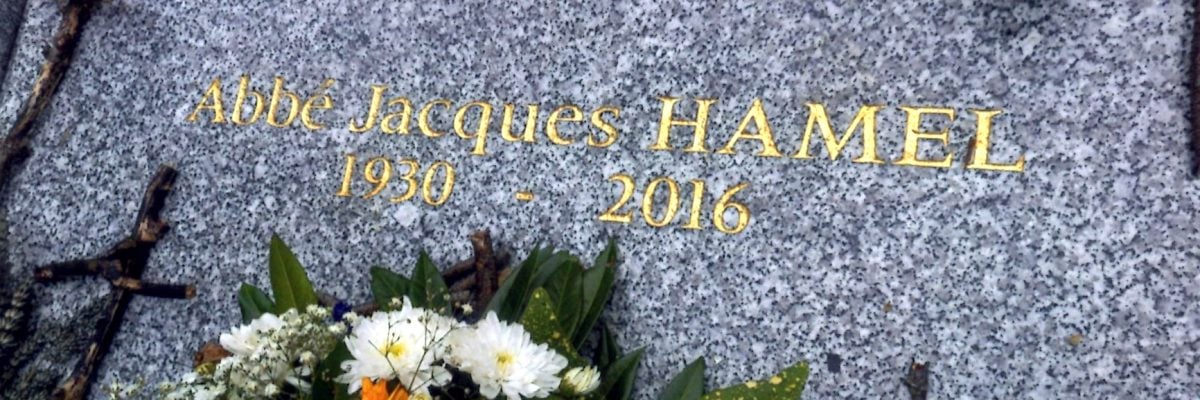
The recent horrific murder of French priest Fr. Jacques Hamel by two ISIS-linked killers has caused worldwide shock and outrage. Not only was Fr. Hamel killed in a gruesome way (having his throat slit), he was killed while saying Mass.
This has led many to discuss his death in terms of martyrdom. Some have spoken as if his martyrdom was certain. For example, writing for the Catholic Herald, Ed Condon states:
Jacques Hamel died a martyr’s death. Of this there can be no question. The 85-year-old priest was at the altar offering the sacrifice of Mass, the moment in which the Church makes present the sacrifice of Christ’s body and blood for the salvation of the world, and his blood was literally mingled with that of Christ.
From the accounts that have emerged thus far, it is not clear that Fr. Hamel’s blood was literally mingled with the Precious Blood from the chalice.
It also is not clear that Fr. Hamel died a martyr.
He may well have done so. I ardently hope that he did, and that he will one day be proclaimed a martyr by the Church, but at this point, the matter is not beyond question.
Being a martyr means more than simply being killed because you are a Christian. It means more than being a priest who is assassinated while saying Mass.
The Church has a specific and constant teaching regarding martyrdom and what is required for it. It may be common to speak of anyone killed on account of the Faith as a martyr, but this is not the Church’s understanding.
Even the Congregation for the Causes of Saints, during the historically unprecedented wave of canonizations that occurred in the pontificate of John Paul II, became a bit loose in applying the term martyr, and in 2006, Benedict XVI wrote an apostolic letter to the Congregation for the Causes of Saints in which he reemphasized the Church’s traditional understanding of what has to happen for a person to be counted as a martyr. He wrote:
The martyrs of the past and those of our time gave and give life (effusio sanguinis [lit., “shedding of blood”]) freely and consciously in a supreme act of love, witnessing to their faithfulness to Christ, to the gospel and to the Church.
If the motive that impels them to martyrdom remains unchanged, since Christ is their source and their model, then what has changed are the cultural contexts of martyrdom and the strategies ex parte persecutoris [“on the part of the persecutor”] that more and more seldom explicitly show their aversion to the Christian faith or to a form of conduct connected with the Christian virtues, but simulate different reasons, for example, of a political or social nature.
It is, of course, necessary to find irrefutable proof of readiness for martyrdom, such as the outpouring of blood and of its acceptance by the victim.
It is likewise necessary, directly or indirectly but always in a morally certain way, to ascertain the odium Fidei [“hatred of the faith”] of the persecutor.
If this element is lacking, there would be no true martyrdom according to the perennial theological and juridical doctrine of the Church.
The concept of “martyrdom” as applied to the Saints and Blessed martyrs should be understood, in conformity with Benedict XIV’s teaching, as “voluntaria mortis perpessio sive tolerantia propter Fidem Christi, vel alium virtutis actum in Deum relatum” (De Servorum Dei beatificatione et Beatorum canonizatione, Prato 1839-1841, book III, chap. 11, 1).
This is the constant teaching of the Church.
The lengthy bit of Latin at the end, from Benedict XVI’s predecessor Benedict XIV, defines martyrdom as:
The voluntary enduring or tolerating of death on account of the Faith of Christ or another act of virtue in reference to God.
As the most recent Benedict makes clear, it is necessary not only to ascertain the odium Fidei or hatred of the Faith on the part of the killer but also “irrefutable proof of readiness for martyrdom, such as the outpouring of blood and of its acceptance by the victim.”
This is what we do not yet appear to have regarding the death of Fr. Hamel.
That he was killed in hatred of the Faith may be regarded as certain. ISIS-linked killers entering a church and killing a priest while saying Mass is a clear sign of hatred of the Faith (barring a truly bizarre and improbable set of circumstances, such as the priest had somehow personally wronged them and they killed him for that reason).
What needs to be established for proof of martyrdom is that Fr. Hamel voluntarily endured or tolerated death on account of the Faith of Christ.
This could be done in a number of ways. For example, it could be done if witnesses in the church gave statements saying that Fr. Hamel faced death saying things like, “I accept my death at your hands for the love of Jesus Christ” or just telling the killers “I forgive you.”
Even apart from such statements, his acceptance of his death for the Faith could be established if he knew that his parish was likely to be targeted by terrorists and he went about his priestly duties anyway, braving the consequences in order to serve others spiritually.
However, such proofs have not yet been offered—at least in the accounts of the event I have seen in the English-speaking press. In fact, one of the witnesses—a nun—indicates that in part of the event that she saw, Fr. Hamel was not accepting his death but resisting:
“They forced him to his knees. He wanted to defend himself. And that’s when the tragedy happened,” said the nun, identified as Sister Danielle.
Sr. Danielle then fled, and it was her efforts that led to the police arriving and shooting the killers. Fr. Hamel may have given signs of his acceptance of his death after she fled, or she simply may not have mentioned them in the brief statement quoted above.
I hope that Fr. Hamel did accept his death in the way needed for martyrdom and that he will be proclaimed both a saint and a martyr.
Until that time, we should be careful about prematurely declaring someone a martyr, just as we should be careful about prematurely declaring someone a saint.



